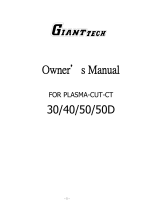Page 4
a. When possible, move the work to a location well away
from combustible; protect the combustibles with a cover
made of fire resistant material.
b. Remove or make safe all combustible materials for a
radius of 35 feet (10 meters) around the work area. Use a
fire resistant material to cover or block all open doorways,
windows, cracks, and other openings.
c. Enclose the work area with portable fire resistant
screens. Protect combustible walls, ceilings, floors, etc.,
from sparks and heat with fire resistant covers.
d. If working on a metal wall, ceiling, etc., prevent
ignition of combustibles on the other side by mobbing
the combustibles to a safe location. If relocation of
combustibles is not possible, designate someone to serve
as a fire watch, equipped with a fire extinguisher, during
the cutting or welding process and for at least one half
hour after the cutting or welding is completed.
e. Do not weld or cut on materials having a combustible
coating or combustible internal structure, as in walls or
ceilings, without an approved method for eliminating the
hazard.
f. Do not dispose of hot slag in containers holding
combustible materials. Keep a fire extinguisher nearby and
know how to use it.
After welding or cutting, make a thorough examination for
evidence of fire. Be aware that easily visible smoke or flame
may not be present for some time after the fire has started.
Do not weld or cut in atmospheres containing
h. Dangerously reactive or flammable gases, vapors,
liquids, and dust.
i Provide adequate ventilation in work areas to prevent
accumulation of flammable gases, vapors, and dust. Do
not apply heat to a container that has held an unknown
substance or a combustible material whose contents, when
heated, can produce flammable or explosive vapors. Clean
and purge containers before applying heat. Vent closed
containers, including castings, before preheating, welding,
or cutting.
j. Only use compressed air to operate the Plasma Welder/
Cutter. Never use other compressed gases.
WARNING
INHALATION HAZARD: Welding and Plasma Cutting
Produce
TOXIC FUMES.
Exposure to welding or cutting exhaust fumes can increase
the risk of developing certain cancers, such as cancer of
the larynx and lung cancer. Also, some diseases that may
be linked to exposure to welding or plasma cutting exhaust
fumes are:
a. Early onset of Parkinson’s Disease
b. Heart disease
c. Ulcers
d. Damage to the reproductive organs
e. Inflammation of the small intestine or stomach
f. Kidney damage
g. Respiratory diseases such as emphysema, bronchitis, or
pneumonia
Use natural or forced air ventilation and wear a respirator
approved by NIOSH to protect against the fumes produced
to reduce the risk of developing the above illnesses.
1. Avoid overexposure to fumes and gases. Always keep
your head out of the fumes. Do not breathe the fumes. Use
enough ventilation or exhaust, or both, to keep fumes and
gases from your breathing zone and general area.
• Where ventilation is questionable, have a qualified
technician take an air sampling to determine the need
for corrective measures. Use mechanical ventilation
to improve air quality. If engineering controls are not
feasible, use an approved respirator.
• Work in a confined area only if it is well ventilated, or
while wearing an air-supplied respirator.
• Follow OSHA guidelines for Permissible Exposure Limits
(PEL’s) for various fumes and gases.
• Follow the American Conference of Governmental
Industrial Hygienists recommendations for Threshold
Limit Values (TLV’s) for fumes and gases.
• Have a recognized specialist in Industrial Hygiene or
Environmental Services check the operation and air
quality and make recommendations for the specific
welding or cutting situation.
2. Always keep hoses away from welding/cutting spot.
Examine all hoses and cables for cuts, burns, or worn areas
before each use. If any damaged areas are found, replace
the hoses or cables immediately.
1. Read and understand all instructions and safety
precautions as outlined in the manufacturer’s Manual for
the material you will weld or cut.
1. Proper cylinder care. Secure cylinders to a cart, wall, or
post, to prevent them from falling. All cylinders should be
used and stored in an upright position. Never drop or strike
a cylinder. Do not use cylinders that have been dented.
Cylinder caps should be used when moving or storing
cylinders. Empty cylinders should be kept in specified areas
and clearly marked “empty.”
2. Never use oil or grease on any inlet connector, outlet
connector, or cylinder valves.
3. Use only supplied Torch on this Inverter Air Plasma
Cutter. Using components from other systems may cause
personal injury and damage components within.
4. People with pacemakers should consult their
physician(s) before using this product. Electromagnetic
fields in close proximity to a heart pacemaker could cause
interference to, or failure of the pacemaker.
5. USE PROPER EXTENSION CORD.
Make sure your extension cord is in good condition.
When using an extension cord, be sure to use one heavy
enough to carry the current your product will draw. An
undersized cord will cause a drop in line voltage resulting
in loss of power and overheating. We recommend that
a 15amp extension cord be used with the 1.5mm
2
cable.
The following Toolex Industrial Extension Leads would be
suitable 594530 10 metre, 594531 20 metre & 594532 30
metre.













